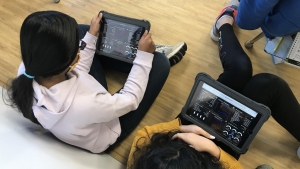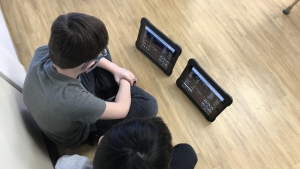Our 2020-21 school year has been a roller coaster ride, as for most school districts across the country. We started the year with half of our students at a time in a hybrid model, then moved to all students in the classroom with desks six feet apart and masks worn; transitioned briefly to completely remote learning when our teacher absences reached critical levels, and then back to all students on campus. We still have students coming and going as they are quarantined, learning from home or logging in for Google Meet lessons. We are continually adjusting to change.
Using the SIMOC Mars habitat simulation in the classroom this year was different in that students were allowed to work together for only short periods of time (less than 15 minutes) with masks worn. Students are resilient and have adjusted to this reality, enjoying any time to work with others. We conducted several sessions with SIMOC as we geared up for a larger project about Mars colonization. I have 5th grade students, so I modified the experience to make it meaningful for ten and eleven year olds. We looked over the simulation together (mirroring on the classroom TV) and talked about some of the major factors in survival (oxygen, water, food, removal of CO2, plant growth, etc.). I showed them how to add and remove panels and how to set up their simulations. Students ran several simulations with different parameters and then reported their findings. I used a Google Form to collect information from students and to get them thinking about what is happening within the simulations.
Following the initial group effort, I encourage students to work out their own simulations, to give them agency over the process and to let them think through the consequences of different decisions. This is a nice introduction to a larger project we will start in a couple of weeks. After learning a little more about Earth and what makes ours a habitable planet, we will research Mars. Students will use Google Mars to choose landing locations for a Martian colony. They will plan materials needed for their mission and design colonies (first on grid paper in a blueprint style) then use their blueprints to make 3D models on Minecraft.edu. Students will present their finished colonies to classmates and will need to prove that their colonies will be safe and habitable using a set of parameters. I believe the SIMOC simulation got them thinking about some of these factors and will help them succeed on their final projects.
In general, students enjoyed using the SIMOC simulation. They understand the basic parameters that make a successful simulation, although we didn’t have time to explore the more complicated data sources and parameters appropriate for older students. They were curious why certain plants grow very quickly (like radishes) and some seem relatively slowly. I told them I don’t have all of the information to guide these answers, but they seemed excited about subsequently growing plants with their Minecraft colonies. I also only had limited knowledge to share about the ECLSS modules and how they work. Students asked for photographs and more information, which extends the learning process.
Students were not always clear if there are acceptable limits to the SIMOC variables, regarding some of their choices. Why not max out everything? 10 ECLSS modules and 2,500 solar panels? I asked students to think through the difficulty of getting large amounts of equipment and materials to Mars, but it seemed difficult for them to visualize these constraints within the SIMOC simulation.
Overall, this was a positive experience that engaged the students in the challenges of the human habitation of the Moon and Mars. It’s not as easy as science fiction leads us to believe, and will take a concerted effort in the coming decades.
Read the full paper published for ICES 2021 …



